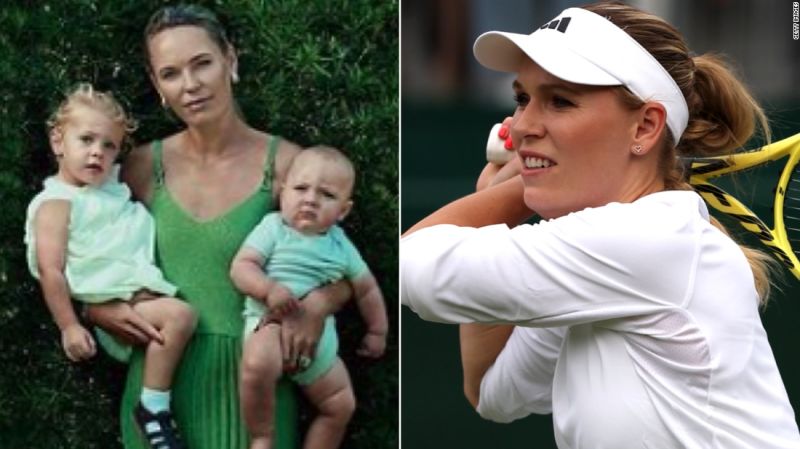New York
CNN
—
Caroline Wozniacki’s return to tennis and the US Open lived up to the hype.
On the first official day of the tournament, former world-ranked No. 1 player is Russian qualifier Tatiana Prozorova, 6-3, 6-2. She defeated Czech player Petra Kvitová, American Jennifer Brady and today she will face Coco Gauff, ranked No. 6, in the round of 16.
After retiring from tennis in 2020 and having two children, the Danish star – currently ranked No. 623 – continues to work to regain the top spot.
Out of retirement this summer, she enters a new chapter in her athletic career as sports leagues, coaches and exercise scientists continue to develop best practices for mothers. who is pro-athlete.
Last year, Wozniacki returned to hardcourt — and surprised herself.
“When my dad visited me in Florida, I realized I needed advice,” he recently wrote in Vogue Magazine. “I hit for 20, 30 minutes — I’m not sure how long, but at one point I looked at him and said, ‘I feel like I’m hitting better than ever. Did I do that?’ ”
He is not.
In fact, she plays so well, she received wild card entries in many tournaments including the final grand slam of the tennis season, the US Open, where nine other mothers also competed in the women’s singles division.
If she succeeds, Wozniacki, 33, will join a short list of mothers who have reached the finals of a grand slam, or won.
Serena Williams played in four grand slam finals after her daughter Olympia was born in 2018, two of them at the US Open. Belgian star Kim Clijsters won the US Open in 2009, defeating Caroline Wozniacki, 7-5, 6-3. She claimed the US Open title again the following year, bringing her daughter, Jada, to the court twice.
Australia’s Margaret Court became the first mother to win the Queens-based tournament in 1973. She also won the French and Australian Opens in the same year, making her and Kim Clijsters the only mothers to win three singles titles. grand slam of the Open Era. Four-time grand slam winner Naomi Osaka recently gave birth in June and is expected to compete in the 2024 Australian Open.
Exceptional talent and drive are only part of the reason why these players have been able to succeed as postpartum athletes. In 1984, the governing body for women’s tennis, the Women’s Tennis Association (WTA), implemented the “Terry Holladay Rule.” Named by a player who petitioned to compete after the birth of her daughterthe rule allows players to compete in the main draw of six tournaments – as long as they return within a year of having a child.
Nearly three decades ago, the WTA implemented a rule change that would affect how female players earn money after maternity leave. It allows players to freeze their ranking in case of injury, illness or pregnancy for up to three years. This ranking can be used to participate in many tournaments, including grand slams, which tend to have the largest prize purses.
But the rule limits how many grand slam players can enter, something tennis pro Taylor Townsend of Chicago wants to change.
“I hope we get more opportunities to play (more) grand slams because for me personally, that’s the biggest payoff,” he said. Townsend, who will also compete in the US Open this year, has a two-year-old son.
No matter what level of income a player earns, the training required to compete and win at the elite level of tennis is intense. Adding motherhood to the mix, according to ESPN commentator and former player Rennae Stubbs, adds new challenges and perspectives to the process.
“It’s really hard to win a grand slam without a kid saying, ‘Mom, when are you coming back?’ ” Stubbs told CNN. He previously coached former world No. 1 players who are Karolina Pliskova and Serena Williams.
“Serena … I think she wants to win the grand slam as a mother more than anything else,” he said. “You have a change in your thought process while tennis is not the most important thing, your son.”
Christine Stromberg, senior manager of Professional Tennis Operations and US Open Player Services said she has seen more players with families at the tournament since she started in 2019. She is working to increase childcare services at the tournament. , including hiring caretakers who speak different languages.
There have also been major changes in the way the medical profession evaluates professional athletes during their pregnancy.
“In the old days, people were told not to exercise too much during pregnancy, so as not to get their heart rate higher than a certain level,” said Dr. Kate Ackerman, an associate professor of medicine at Harvard University Medical School who leads the Wu Tsai Female Athlete Program at Boston Children’s Hospital.
Serena Williams famously won her seventh Australian Open title in 2017 while eight weeks pregnant.
“That (advice) is kind of thrown out the window as we see people being carefully monitored and pushed, pushing exercise levels through their pregnancy,” Ackerman said. “We learn a lot from elite level athletes because they are the most impressive guinea pigs.
“The biggest thing we try to convey to all of our athletes is not to beat themselves up, that we’re trying to figure it out and every person’s situation is unique,” Ackerman added. “We have to meet them where they are.”
